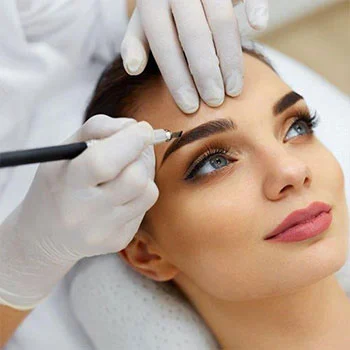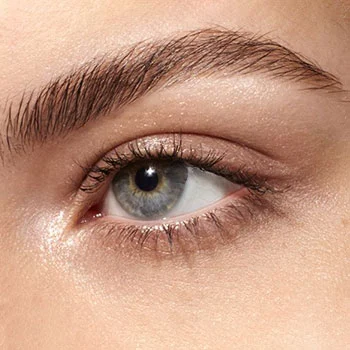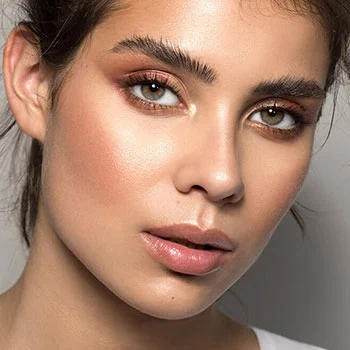Introduction
The quest for perfectly shaped and defined eyebrows has led to the rise of innovative beauty techniques, with eyebrow tattooing taking center stage. In this article, we delve into the art of eyebrow tattoos, exploring what it is, the procedure itself, the expected results, aftercare, and potential side effects. We'll also compare an eyebrow tattoo with popular alternatives like microblading and microshading, analyze the cost implications, and provide a balanced view of the pros and cons. By the end, you'll have a thorough understanding of eyebrow tattooing, empowering you to make an informed decision about this
What is Eyebrow Tattoo?
Eyebrow tattooing, also known as permanent makeup or cosmetic tattooing, is a technique that involves the implantation of pigment into the skin to create the appearance of well-defined and fuller eyebrows. This semi-permanent procedure is gaining popularity among individuals seeking a long-lasting solution to sparse, uneven, or thinning eyebrows. By carefully depositing pigment in the desired shape and color, eyebrow tattoos can enhance facial features, frame the eyes, and boost self-confidence.
How Is It Done?
The eyebrow tattooing process is a meticulous and precise art that requires the expertise of a skilled tattoo artist. During the procedure, the artist uses a handheld tool with a cluster of tiny needles to create small incisions in the skin's top layers. Pigment is then deposited into these incisions, mimicking the appearance of natural eyebrow hairs. The process typically takes about 1 to 2 hours, depending on the complexity of the desired design and the chosen technique, which may include microblading, microshading, or a combination of both.
How to Prepare for Eyebrow Tattooing?
To prepare for an eyebrow tattoo procedure, here are some general guidelines to follow:
- Do Your Research: Find a reputable and experienced professional artist who specializes in eyebrow tattooing. Look at their portfolio, read reviews, and ensure they have proper certifications.
- Consultation: Schedule a consultation with the artist before the procedure to discuss your expectations, desired shape/color, and any concerns or questions you may have.
- Avoid Blood Thinners: In the days leading up to your appointment, avoid consuming blood-thinning substances such as alcohol or aspirin that can increase bleeding during the procedure.
- Skip Caffeine: Consider avoiding caffeine on the day of your appointment as it can make you more sensitive to discomfort.
- Arrive Makeup-Free: Come to the appointment without any makeup applied on or around your eyebrows so that the artist can see your natural brow shape and color.
- Communicate Medical Conditions/Medications: Inform the artist about any medical conditions or medications you are currently taking to ensure there are no contraindications or complications during the procedure.
- Plan for Healing Time: Keep in mind that there will be a healing period after getting an eyebrow tattoo where scabbing and flaking may occur. Plan accordingly by avoiding activities like swimming, excessive sweating, or exposure to direct sunlight during this time.
- Follow Aftercare Instructions: The artist will provide specific aftercare instructions for proper healing and maintenance of your new eyebrows—follow them diligently for optimal results.
Aftercare and Recovery
Proper aftercare is crucial to ensure optimal healing and long-lasting results following an eyebrow tattooing procedure. After the session, it is important to keep the treated area clean and avoid touching or picking at any scabs that may form. Applying a thin layer of healing ointment as recommended by the artist helps soothe the skin and promote proper recovery. It is advised to avoid exposure to direct sunlight, swimming pools, saunas, and excessive sweating during the initial healing phase to prevent complications.
Additionally, refraining from applying makeup directly on the treated area for a few days allows for better healing. Following these aftercare instructions diligently not only aids in preventing infections but also contributes significantly to maintaining the integrity of the tattooed eyebrows over time.
Regular touch-ups may be necessary depending on individual factors such as skin type and desired longevity of results; consulting with your tattoo artist will help determine when additional sessions should be scheduled for maintenance purposes.
When to See Results?
After the initial session, the eyebrows may appear darker and more defined than expected. However, over the next few days, the color will gradually fade to a more natural shade. It takes approximately 4 to 6 weeks for the skin to heal completely and for the final results to be visible. During this healing period, it's normal for the eyebrows to experience some scabbing and flaking as part of the body's natural recovery process.
Who Is Eyebrow Tattoo Right For?
Eyebrow tattoos can be suitable for various individuals, depending on their specific needs and preferences. Here are some situations where eyebrow tattoos may be a good option:
- Individuals with Sparse or Thin Brows: Eyebrow tattoos can help enhance the appearance of thin or sparse eyebrows by adding fullness, shape, and definition.
- Those with Hair Loss Conditions: People experiencing hair loss conditions like alopecia or undergoing medical treatments that result in eyebrow hair loss may consider eyebrow tattoos as a way to restore the appearance of natural brows.
- Busy Lifestyles: For individuals who lead busy lifestyles and prefer not to spend time filling in their eyebrows daily, an eyebrow tattoo can provide convenience by eliminating the need for regular makeup application.
What Are the Side Effects?
While eyebrow tattooing is generally considered safe, like any cosmetic procedure, it comes with potential side effects. Some individuals may experience mild redness, swelling, or tenderness around the treated area immediately after the procedure, but these usually subside within a few days. In rare cases, allergic reactions to the pigments may occur, so it's essential to undergo a patch test before the full procedure to check for any allergies. Additionally, improper aftercare may lead to infections or scarring.
Eyebrow Tattoo vs. Microblading vs Micoshading
Eyebrow tattooing, microblading, and microshading are three techniques used to enhance the appearance of eyebrows, which differ in a few ways. Here are some key differences between the three:
Eyebrow Tattoo:
- Technique: Eyebrow tattooing involves using a handheld machine with needles to deposit pigment into the skin's top layers, creating a powdered or shaded effect.
- Depth of Pigment Placement: The pigment is deposited deeper into the skin compared to microblading, resulting in longer-lasting results.
- Duration: Eyebrow tattoos typically last for several years before requiring touch-ups or color-refreshing sessions.
- Appearance: The finished look tends to be more defined and filled-in, resembling softly powdered or shaded eyebrows.
Microblading:
- Technique: Microblading uses a manual handheld tool with ultra-fine needles to create precise hair-like strokes by manually implanting pigment into the superficial layers of the skin.
- Depth of Pigment Placement: The pigment is placed shallower in comparison to eyebrow tattoos, resulting in semi-permanent results that may fade over time.
- Duration: Microbladed eyebrows generally require more frequent touch-ups due to their shorter lifespan compared to eyebrow tattoos. Typically, they need refreshing every 1-2 years depending on individual factors such as skin type and lifestyle.
- Appearance: Microbladed brows provide a natural-looking result as it mimics actual eyebrow hairs. The technique creates realistic hair-like strokes that blend seamlessly with existing brow hairs.
Microshading:
- Technique: Microshading involves using either a manual handheld tool or an electric machine to create small dots or lines, resulting in a soft shading effect.
- Depth of Pigment: The pigment is placed slightly deeper into the skin compared to microbladed strokes, resulting in a softer and more diffused appearance.
- Duration: Generally requires touch-ups sooner than microbladed eyebrows as it involves slightly deeper implantation. Results usually last around 1-2 years before needing refreshing sessions.
- Appearance: Offers a softer appearance resembling makeup shading. It fills in larger sections of the brows with tiny dots or lines for a powdered effect that adds depth and dimension.
When choosing between eyebrow tattoo, microblading, and microshading, it's important to consider factors such as desired longevity of results, preferred appearance (soft powder vs. hair-like strokes), maintenance requirements, personal preferences for touch-up frequency, and suitability based on individual skin type. Consulting with an experienced professional can help you make an informed decision about which technique best aligns with your needs and aesthetic goals.
How Much Does Eyebrow Tattoo Cost?
The cost of an eyebrow tattoo procedure varies depending on factors such as the location, the expertise of the artist, and the chosen technique. On average, eyebrow tattooing can cost between $300 to $800 per session. While it may seem like a significant investment, the semi-permanent nature of the procedure makes it a cost-effective choice in the long run, as it eliminates the need for daily eyebrow makeup.
Pros and Cons of Eyebrow Tattoo
Pros:
- Long-lasting results that save time on daily makeup application.
- Enhances facial features and provides a boost in self-confidence.
- Suitable for individuals with thinning or uneven eyebrows due to various reasons.
- Semi-permanent nature allows for flexibility in adjusting the eyebrow appearance as trends change.
Cons:
- Potential side effects like redness, swelling, or allergic reactions.
- The need for proper aftercare and multiple sessions for optimal results.
- Semi-permanent nature may not appeal to individuals seeking a temporary change.
Takeaway
Eyebrow tattooing presents an exciting opportunity to achieve the eyebrows of your dreams with lasting precision. The procedure offers a transformative solution for individuals seeking natural-looking, well-defined brows that enhance their overall beauty and boost self-esteem. By understanding the process and the aftercare requirements and weighing the pros and cons, you can confidently make a decision that aligns with your beauty goals. Remember, the key to a successful eyebrow tattoo lies in choosing a reputable and experienced artist who can unleash the true potential of your brows, allowing you to embrace the beauty of eyebrow tattooing with timeless confidence and elegance.
Frequently Asked Questions
Does eyebrow tattooing hurt?
Eyebrow tattooing can cause some discomfort, but it varies from person to person. Numbing creams are commonly used to minimize pain during the procedure.
How long does the result of an eyebrow tattoo last?
The duration of eyebrow tattoo results can vary depending on several factors, including the individual's skin type, lifestyle, and aftercare. Generally, eyebrow tattoos last between one to three years before they begin to fade. However, touch-up sessions are often recommended every 12-18 months to maintain the desired appearance and longevity of the tattooed eyebrows. It's important to note that each person's experience may differ based on their unique circumstances and how well they follow proper aftercare instructions provided by the professional artist.
Can I have eyebrow tattoo if I’m pregnant?
It is generally recommended to avoid getting an eyebrow tattoo while pregnant. Hormonal changes during pregnancy can affect the skin's sensitivity and healing process.
Can I have microblading over my eyebrow tattoo?
In most cases, it is possible to have microblading done over an existing eyebrow tattoo. However, to determine if it is feasible and the success of the procedure, several factors should be taken into account:
Tattoo Fading: The existing eyebrow tattoo should be significantly faded or lightened for the microblading strokes to show effectively.
Skin Condition: The condition of the skin around the tattooed area is important. If there are any complications or issues with healing, additional scar tissue, or irregularities, it may affect the results of microblading.
Moreover, during a consultation, the artist will evaluate your existing eyebrow tattoo and discuss whether microblading can be performed over it successfully. They will consider factors such as color saturation, the previous technique used in tattooing, and overall suitability for achieving desired results.
Can eyebrow tattoos be removed?
Yes, eyebrow tattoos can be removed, but the process can be challenging. Tattoo removal techniques such as laser treatment or tattoo removal creams may be used to fade or remove the pigment from the skin. However, complete removal may not always be possible, and multiple sessions might be required for satisfactory results.




